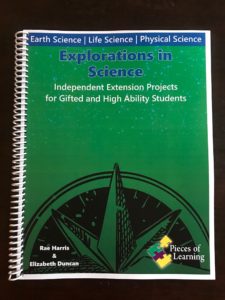 I am pleased to announce the publication of Explorations in Science: Independent Extension Projects for Gifted and High Ability Students. The book will help teachers differentiate instruction in their classrooms for their advanced learners. A companion volume, Explorations in Social Studies,is due out in January.
I am pleased to announce the publication of Explorations in Science: Independent Extension Projects for Gifted and High Ability Students. The book will help teachers differentiate instruction in their classrooms for their advanced learners. A companion volume, Explorations in Social Studies,is due out in January.
Gifted education was my specialty during my teaching career. I worked directly with small groups of gifted and high-ability students, as well as functioned as a resource for teachers who taught in mixed-ability classrooms.
Gifted students have abilities that place them in the top 10% of the population and their needs are often overlooked in a one-size-fits-all educational climate. These students are expected to sit through the presentation and review of information that they already know or that they learn very quickly.
To address this problem, over the years I developed extensions of curriculum that advanced students could work on independentlyduring class, while the teacher and other students in the class were involved grade-level instruction or review. I found these worked well to keep advanced students engaged in school and excited about learning. These were the genesis of Explorations.
My colleague, friend and co-author Rae Harris and I thought these kinds of projects we had developed at our schools would be helpful to teachers and welcomed by students. After much thought, we started to call our projects “Explorations.” We knew there were few, if any, resources that were similar to what we wanted to write.
We contacted a publisher of gifted and talented resources and proposed our idea. We included some sample Explorations and the many reasons we were qualified to write thisbook. “Pieces of Learning Press,” a leading publisher of gifted and talented materials, wrote back saying, “We like it!” A contract, reviewed by our legal team (our husbands), was promptly signed. Then we went to work.
Consulting the NextGen Science standards, we determined the curricular topics we needed to cover. The science standards led us to divide the book into three sections: Earth Science, Life Science and Physical Science. We decided that ten Explorations per standard would allow teachers and students ample choice. Our Exploration topics would include topics like volcanoes and space, endangered animals and human body, and electromagnetism and light waves.
Rae and I designed a teacher and student-friendly, two-page format that focused on interesting topics that extend the science curriculum for 3rd-6thgrades. We wrote each Exploration with an educational focus, complex and rigorous important questions, several creative project options and a structured project completion tasks. We dreamed up all the extras we knew teachers would need, like student directions and evaluation rubrics, and created these as well.
Over the course of several months, we met weekly at our local library work on the book. We delved into topic areas and explored resources. I immersed myself in each topic, researching (for example) physical scientists and their theories, the newest missions in space or alternative energy sources. The best part was thinking up the creative projects that were challenging and interesting, as well as do-able by a student working independently in a classroom.
We did final edits on the book and it was submitted. We received and reviewed the proof and found a surprising number of errors. We corrected the proofs, got a second proof… it was getting there… more corrections, then it was finalized. We were excited to get a peek at the cover and back of the book in an email.
Finally, it was done and we held a copies of the finished product in our hands. And, it is ready for the publisher’s booth at the National Association of Gifted and Talented (NAG/T) annual conference, which starts today in Minneapolis.
I imagine my book, Explorations in Science,finding its way into the hands of teachers in a variety of settings- in a large urban classroom or a small rural school or a homeschool table. I picture students, like Trevon or Katie or Maria or Edwin (real people I have taught) connecting with learning at a deep level while working through an Exploration. It is my great hope that my own creative work and ideas will make a difference in the education of a child.
